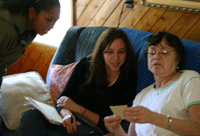
About Sociolinguistic Research
What is Sociolinguistics?
Sociolinguistics is the study of language in its social context. The term encompasses a wide range of research questions and pursuits within linguistics, including but not limited to:
How do people use language to define themselves or to set themselves apart from others?
How, when, and why does language change? What kinds of people start language change?
What parts of speech change as people switch between different social situations? What parts stay the same? And why?
What causes listeners to think of one type of language as "better" than another?
How does language vary depending on the race, class, and gender of a speaker?
How do external factors such as social tension, racism, sexism, media representation, popular entertainment, etc. affect the way people use language?
Linguist Moti Lieberman explains sociolinguistics in his show "The Ling Space"
From descriptive studies of dialects, to investigations of language variation and change, to analyses of the roles that language or particular linguistic features play in the construction of individual or group identities, these sorts of studies are all sociolinguistic.
How does Sociolinguistic Research work?
Sociolinguistic fieldwork is the recording of speech within a natural context, such as a family dinner conversation. The goal of fieldwork is to capture the way people actually talk in casual settings. This gives researchers the best possible representation of the natural linguistic world.
The biggest challenge to collecting data is that when people know they’re being listened to, they tend to pay more attention to their speech than normal, or they begin to treat researchers formally. This gives us warped data – we end up learning nothing about the community besides how they talk when they’re kind of nervous! The best way we know how to get around this problem is through a Sociolinguistic Interview, which is an interview style designed to be as natural and casual as possible.
We do this kind of research to understand as fully as possible how people in a community speaks to one another. Studying language in social contexts like this can reveal patterns in the way people talk that socially-devoid research can completely miss. As an example, check out this project by the Atlantic. By correlating specific vocabulary terms with a social factor like geography, they were able to find clear patterns in the way US citizens express themselves:
What is a Sociolinguistic Interview Like?
Sociolinguistic Interviews try to make a formal situation casual. In order to collect speech data, you have to make people talk – that’s why linguists conduct interviews. But interviews are traditionally formal situations that might remind people of applying for jobs or other stressful contexts. Recording conversations can make the situation even worse: people may tense up, causing their speech to become very different from what they would use among friends or other close community. This is a problem for sociolinguists, who are generally interested in studying people’s most natural speech styles.
Sociolinguistic interviews try to get around this observers’ paradox by taking our time and asking questions that will elicit casual, relaxed conversation. We ask questions about topics like childhood games or current social activities. Asking about local customs makes our social data better, teaches us about the community we’re researching, and also helps people to talk naturally to the researchers. The LLP especially likes asking questions about local culture and society – it helps us in the “Life” part of “Language and Life”!

Sample Interview Questions
- What was it like growing up around here?
- What games did you and your friends play when you were kids?
- Do you have any friends that aren't from around here? What are they like?
Sociolinguists also sometimes want more formal data, which we gather in the form of elicitation tasks. Elicitation tasks are constructed to target specific information about a speech style, like special vocabulary or a particular sound.

Sample Elicitation Tasks
- What do you call people who aren’t from town? That is, do you have a word (or words) for visitors?
- Please read the following list of words out loud: “hawk”, “hock”, “pin”, “pen”, …
Couldn’t You Just Record People Without Them Knowing?
One obvious solution to getting natural speech data would be “interviewing” someone and recording without their knowledge. But that’s not something we do.
People are sensitive – rightly so – to what they’ve said “on record.” To not give someone a choice between what is or isn’t on record is unethical. This is especially true in a research position, where making calls like that could be an abuse of power.
Secondly, sociolinguistic research depends on a good, open relationship with a community of speakers who are willing to share their time and their speech with the researchers. If you’re dishonest with your informants and they discover it, they will most likely not be interested in helping you anymore – and with good reason!
What Happens After the Interview?
Linguists collect interviews in order to look for patterns in the speech of a community. The specific research question depends on the researcher and the project, but, typically, research questions involve comparing a social factor (like gender, race, class, region, or age) with a specific aspect of speech (a sound, a grammatical pattern, etc.)
Researchers can find answers to their questions by either:
-
- Close Listening: analysts can just listen over and over in recordings for every instance of a specific feature. This may involve transcribing the interviews also. After listening and counting, they count how many times their feature appeared vs. how many times it could have occured in their interviews, and compare that statistic between speakers or communities. This style is most common when the feature in question has to do with grammar, because it’s easy for the human ear to pick up.
- Using Linguistic Software: more minute features, like changes in how vowels are formed, are too difficult for humans to accurately record. For these questions, researchers can digitize and transcribe interviews and then analyze the accoustics of the voice using specialized software tools like Praat.
These are just a couple of examples of the sorts of analyses that sociolinguists do with their interview data. For some real-life examples of the sorts of analyses that are undertaken by linguists, check out some of the NCLLP’s field sites.
What Makes the Language and Life Project’s Research Special?
We give back to every community we research. There is a long, unfortunate history of exploitation in the social sciences. Many researchers in the past have treated the communities they research like “subjects” and nothing more. We try to avoid this by adhering to the Principal of Linguistic Gratuity, which was coined in 1993 by our founder Walt Wolfram:
“Investigators who obtained linguistic data from members of a speech community should actively pursue ways in which they can return linguistic favors to the community”
(Wolfram 1993: 227)

Through the years, we have worked with local communities to establish museum exhibits, co-create documentaries, publish local narratives, and more.